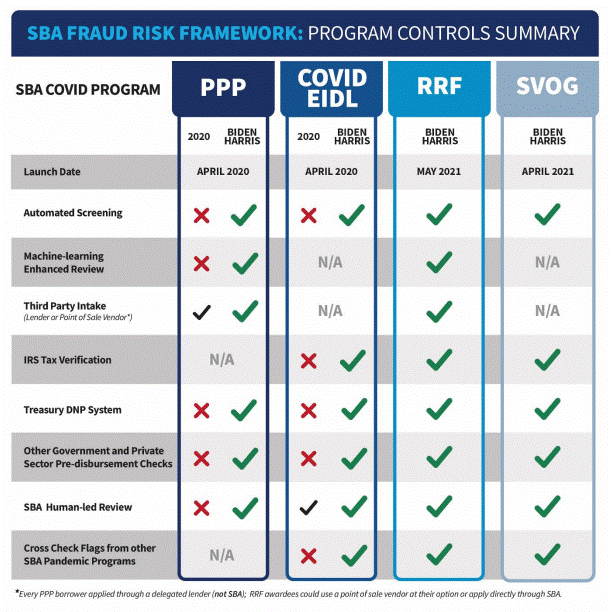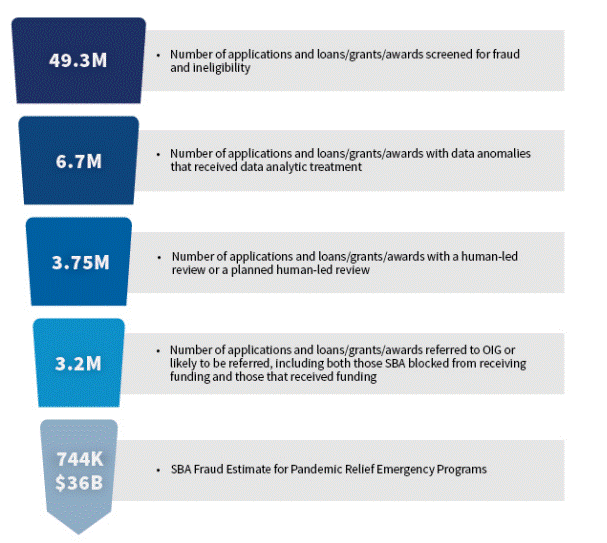 Chris Crum writes for Small Business Resources about what's new for small business. Chris was a featured writer with the iEntry Network of B2B Publications where hundreds of publications linked to his articles including the Wall Street Journal, USA Today, LA Times and the New York Times. Chris Crum writes for Small Business Resources about what's new for small business. Chris was a featured writer with the iEntry Network of B2B Publications where hundreds of publications linked to his articles including the Wall Street Journal, USA Today, LA Times and the New York Times.
|
SBA Report Details Actions to Prevent, Detect, and Tackle FraudThe United States Small Business Administration (SBA) recently released a report on anti-fraud control measures in small business pandemic relief programs, finding that eighty-six percent of fraud in such programs occurred in the first nine months of the pandemic. The report also details the Administration’s actions to prevent, detect, and address fraud. It highlights how the SBA has tackled restoring fraud measures in pre-existing relief programs, enhanced fraud controls in new programs, and supported cross-agency efforts to bring criminals who are guilty of fraud to justice. “Pandemic relief programs, including those supported by President Biden’s American Rescue Plan, have driven a historic economic recovery, including saving millions of businesses and creating over 13 million jobs since 2021,” commented SBA Administrator Isabella Casillas Guzman. “SBA’s COVID relief programs were large-scale and significant undertakings; and the agency has analyzed, evaluated, and taken action to incorporate the latest methods and technologies along the way. With this report, SBA is detailing the effective measures added to fight fraud and hold bad actors responsible, as well as recommendations of best practices to ensure future emergency small business programs are optimized from the start.” The report looks at the total impact of fraud across the Paycheck Protection Program (PPP) and COVID-19 Economic Injury Disaster Loan Program (COVID-EIDL). According to the SBA, it is the most thorough analysis available of the initial fraud prevention measures, new controls put in place to prevent and detect fraud, and the overall impact of fraud on the pandemic relief programs. The report details new anti-fraud measures deployed in 2021 in PPP and COVID-EIDL, including the reinstatement of checking applications against Do Not Pay databases, the checking of tax transcripts to validate application information in the COVID-EIDL programs, and the establishment of a new Fraud Risk Management Board.
The measures allowed the SBA to block over 21.3 million applications, including duplicate applications, ineligible applications, and attempted fraud. They achieved record low fraud rates for new relief programs and supported the recovery of $30 billion from pandemic relief emergency programs. Some other stats of note include:
The report includes some recommendations to mitigate fraud through the design of relief programs. These recommendations include the expansion of government data-sharing. "As outlined in President Biden’s Pandemic Anti-Fraud Proposal, increasing access to government datasets, and expanding validation services would further SBA’s ability to prevent fraud on the front end," the Administration explains. They want to “grant SBA digital, real-time access to government payroll data, as well as tax identification data, so that SBA can more quickly verify applicant information.” Another recommendation is to "build now to save later" by establishing the statutory framework in advance of an emergency, so SBA personnel and procedures can "move quickly and with a full range of controls in the event of a crisis. Finally, the Administration recommends preventing fraud rather than chasing it by focusing efforts on up-front fraud control measures rather than on recovery efforts. Those interested in all the fine details of the SBA’s efforts and recommendations can find the full report here. Read other business articles |

